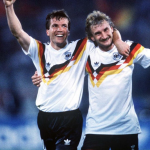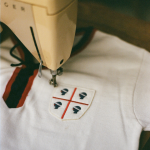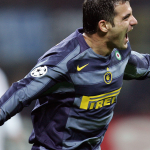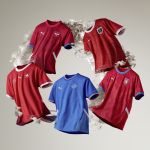
When Umbro followed adidas' example
The shape revolution and geometric jerseys in football
April 7th, 2023
It is said that imitation is the sincerest form of flattery but in reality copying a successful idea is the easiest way to run for cover and try to achieve immediate results. This applies to all fields, all the more so in the world of fashion where keeping up with the times is a matter of survival, an aspect that must necessarily be visible in every collection. Fabrics, colours, shapes: every detail that works for a company is taken and reworked by its competitors. Or rather: it is copied.
At the end of the 1980s and the beginning of the 1990s, football experienced its wave of cubism: footballers began to wear shirts with sharp, angular shapes in which geometry took precedence over any other fantasy. The first company to bet on this trend was adidas with the uniform made for the Netherlands for EURO 1988, a geometrically patterned shirt in which orange and white blurred into each other. In the following years came other different pattern shapes, some of which were copied faithfully.
For the 1990/91 season, in fact, Umbro created an away uniform for Venezia that was reminiscent in every way of the shirt worn by West Germany a few months earlier during the World Cup in Italy. It was made by adidas with an angular pattern representing the colours of the German flag with broken bars running from the shoulders down the length of the chest. That shirt broke with tradition as until then Germany had always worn white uniforms with black borders. Umbro for Venezia presented the same angular pattern, reproduced in the club's social colours: green, black and orange. The one and only real difference was the position of the technical sponsor's logo, as Umbro decided to insert it in a small gap created between the coloured bands and the large horizontal sponsor's stripe instead of at the top right.
A blatant copy of the adidas branded shirt, which went under the radar only because Venezia were playing in Serie C that season, but which was part of a wider trend. Umbro was in fact the brand that more than any other understood the success of adidas' geometric intuition and introduced it into its own collections, starting with the away shirt made for Ajax in the 1989/90 season. This was a blue jersey in which red and white squared confetti alternated, the first experiment on a graphic level after a series of stylistic decisions such as the insertion of polo or crew neck collars with button fasteners with which Umbro had begun its operation of rejuvenation by replacing the classic deep V-neck collars of the 80s.
In the following years the geometric revolution of the English company found its way onto all the shirts bearing the double rhombus logo: from Chelsea to Galatasaray, from Napoli to Inter via Scotland, Celtic, Northern Ireland and Latvia. The geometric shapes became Umbro's trademark, confirming that imitation is the sincerest form of flattery but above all the easiest way to get results.




















